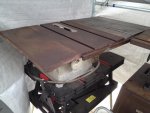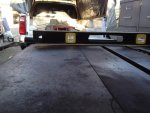Carol Reed
In Memoriam
- Messages
- 5,533
- Location
- Coolidge, AZ
This is one of the saws that followed me home a few weeks ago. I was looking for something to renovate for the book to show what could be done to a 'lesser' saw so that it would function much like a top of the line cabinet saw. No, I am not trying to make a silk purse out of a sow's ear, as my grandma used to say. But the reasons and process will be detailed in the book. Here I will share the process of getting it ready to use initially.
The Timberline was manufactured in the late '40's and early '50's. Lots of cast iron. Massive motor. They were marketed as 8" and 10" saws. Mine had a 7 1/4" blade on it. Not sure a 10" would fit, but that is a subject for another day. Here is what I am starting with:



It sat on my new pop-up table for a couple of weeks. Did I mention it is/was heavy?

That doesn't look good.

That REALLY doesn't look good. Hope the table recovers. Time to start stripping stuff off of it to lighten the load.
And speaking of bending, is that what I think it is?

A closer look or two.


Looks like this support didn't help much.

To be continued...
The Timberline was manufactured in the late '40's and early '50's. Lots of cast iron. Massive motor. They were marketed as 8" and 10" saws. Mine had a 7 1/4" blade on it. Not sure a 10" would fit, but that is a subject for another day. Here is what I am starting with:



It sat on my new pop-up table for a couple of weeks. Did I mention it is/was heavy?

That doesn't look good.

That REALLY doesn't look good. Hope the table recovers. Time to start stripping stuff off of it to lighten the load.
And speaking of bending, is that what I think it is?

A closer look or two.


Looks like this support didn't help much.

To be continued...



